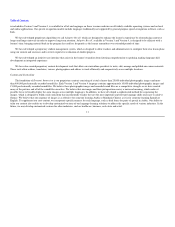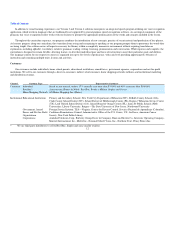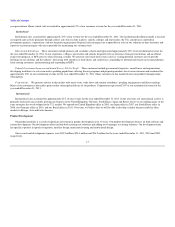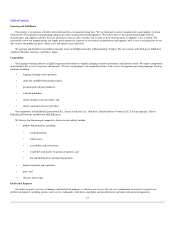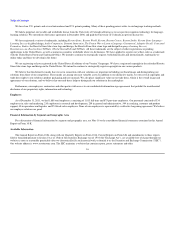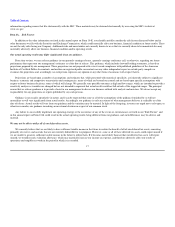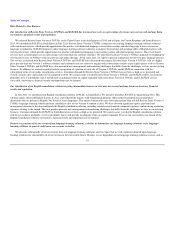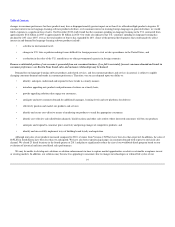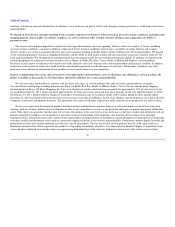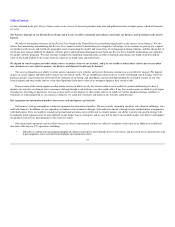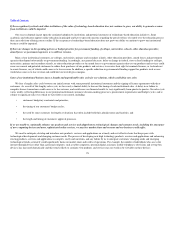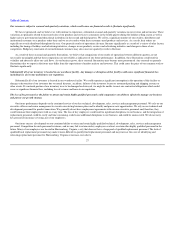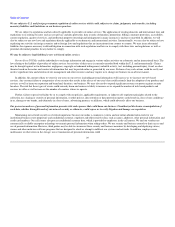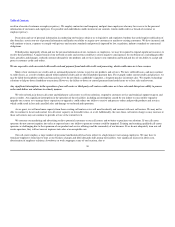Rosetta Stone 2011 Annual Report Download - page 22
Download and view the complete annual report
Please find page 22 of the 2011 Rosetta Stone annual report below. You can navigate through the pages in the report by either clicking on the pages listed below, or by using the keyword search tool below to find specific information within the annual report.
Table of Contents
solutions. A decline in consumer demand for our solutions, or any failure on our part to satisfy such changing consumer preferences, could harm our business
and profitability.
We depend on discretionary consumer spending in the consumer segment of our business. Adverse trends in general economic conditions, including retail
shopping patterns, airport traffic or consumer confidence, as well as numerous other external consumer dynamics may compromise our ability to
generate revenue.
The success of our business depends to a significant extent upon discretionary consumer spending, which is subject to a number of factors, including
general economic conditions, consumer confidence, employment levels, business conditions, interest rates, availability of credit, inflation and taxation.
Adverse trends in any of these economic indicators may cause consumer spending to decline further, which could hurt our sales and profitability. We depend
on the continued popularity of malls as shopping destinations and the ability of mall anchor tenants and other attractions to generate customer traffic for our
retail mall-based kiosks. We also depend on continued airline travel to generate traffic for our retail kiosks located in airports. In addition, we depend on the
continued popularity of traditional store-based retailers such as Barnes & Noble, Best Buy, Costco, Books-A-Million and Staples to sell our products.
Decreases in mall, airport or traditional store-based retail traffic adversely affect our consumer sales and our profitability and financial condition. In addition,
an increase in the taxation of online sales could result in reduced online purchases or reduced margins on such sales. Furthermore, consumers may defer
purchases of our solutions in anticipation of new products or new versions from us or our competitors.
Because a significant portion of our sales are made to or through retailers and distributors, none of which have any obligation to sell our products, the
failure or inability of these parties to sell our products effectively could hurt our revenue and profitability.
We rely on retailers and distributors, together with our direct sales force, to sell our products. Our sales to retailers and distributors are highly
concentrated on a small group, including Amazon.com, Barnes & Noble, Best Buy, Books-A-Million, Staples, Costco, Navarre and our home shopping
network partner in Korea, GS Home Shopping, Inc. Sales to or through our retailer and distributors accounted for approximately 14% of our revenue for the
year ended December 31, 2011, which was down approximately 4% from our revenue generated from these channels for the year ended December 31, 2010.
On February 16, 2011, Borders filed for Chapter 11 bankruptcy reorganization and we recorded a charge of $0.9 million during the three months ended
December 31, 2010 associated with the potential loss of our accounts receivable from Borders. In July 2011, Borders announced plans to close down all of the
Company's retail stores and liquidate inventory. The liquidation of inventory by Borders reduced foot traffic and sales of our products by our other retailers.
We have no control over the amount of products that these retailers and distributors purchase from us or sell on our behalf, we do not have long-term
contracts with any of them, and they have no obligation to offer or sell our products or to give us any particular shelf space or product placement within their
stores. Thus, there is no guarantee that this source of revenue will continue at the same level as it has in the past or that these retailers and distributors will not
promote competitors' products over our products or enter into exclusive relationships with competitors. Any material adverse change in the principal
commercial terms, material decrease in the volume of sales generated by our larger retailers or distributors or major disruption or termination of a relationship
with these retailers and distributors could result in a potentially significant decline in our revenue and profitability. Furthermore, product display locations and
promotional activities that retailers undertake can affect the sales of our products. The fact that we also sell our products directly could cause retailers or
distributors to reduce their efforts to promote our products or stop selling our products altogether. As evidenced by the Borders Chapter 11 liquidation, book
stores and other traditional store-based retailers are experiencing diminished foot traffic and sales. Reduced customer foot traffic in these stores is likely
20



